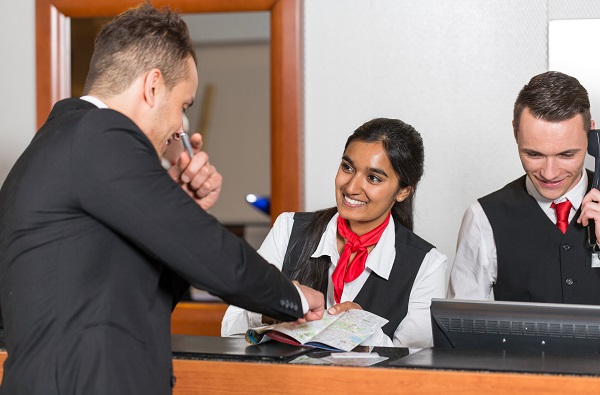
The shocking truth about accommodation accidents
Injuries happen without warning in every workplace – but particularly ours.
Accommodation and food services has an unenviable record on workplace incidents which sees the sector named in the government’s Australian Work Health and Safety Strategy as a priority area for reducing “high numbers of work-related injuries and illnesses”.
We make around 7,000 serious claims per year, or six percent of the total number recorded in Australia.
In NSW hospitality, injuries such as sprains and strains account for about one-third of all incidents. Burns are also commonplace, with more than 1500 the past three years put down to numerous factors including hazardous chemicals, boiling liquids, stress and fatigue.
[pro_ad_display_adzone id=”37778″ align=”left” padding=”20″]Other risk factors include lacerations and amputations from machinery and equipment, electric shocks (when vacuuming wet carpets or cleaning ovens, for example) and violence and aggression due to drugs.While everyone from industry leaders to union reps to the community has a part to play in reducing incident risk, it is vital that individual business understand and embrace their first aid responsibilities.
Risk assessment
First aid requirements vary from one workplace to another, so consider all your potential hazards when deciding what you need to have in place through a thorough risk assessment.
Think about:
- The size and location of your workplace, e.g the distance between work areas and response times for emergency services.
- Numbers of staff and level of risk. In low-risk workplaces a first aid room should be provided when there are more than 200 workers, and in high-risk workplaces when there are more than 100. There should be one trained and certificated first aider for every 50 workers in low-risk workplaces and one for 25 workers in high-risk workplaces.
Laws for first aid
Each state or territory has its own work health and safety authority which can advise on workplace safety compliance. But general first aid legal obligations, plus practical advice about working out first aid requirements, equipment, facilities and training needs, are set out in clause 42 of Safe Work Australia’s Work Health and Safety Regulations and Code of Practice: First Aid in the Workplace.
Every hospitality business must give workers access to both first aid equipment and trained first aiders.
First Aid Courses
Australia boasts several recognised training organisations (RTOs) which provide hospitality staff with the skills to respond to everyday accidents and emergencies. Each one issues nationally-recognised qualifications and statements of attainment and offers the regular refresher courses required for current first aid officer certification.
They can also provide a comprehensive service ranging from workplace assessments through training and equipment provision to online incident management reporting.
As a general rule, first aiders are required to attend the Provide First Aid HLTAID003 course which equips them with a range of skills to manage emergency situations and provide a first aid response.
However, it’s important to reiterate that compliance varies from state to state. Victoria’s minimal acceptable level of training for first aiders is, for example, a senior first aid certificate or the Apply First Aid HLTFA301B.
For those working in pool environments, The Royal Life Saving Pool Lifeguard Certificate is a qualification recognised throughout Australia and in many countries around the world. The SISSS00111 Pool Lifeguard Skill Set covers first aid, resuscitation, swimming and water safety and teaches rescue and emergency response techniques, aquatic supervision, risk management, public relations, communication, conflict management and basic technical pool operations.
Tooling up
Any first aid kit used in hospitality environs should include a range of components suitable for treating injuries such as cuts, burns and bruising, particularly blue metal strips and plasters which are strong and highly visible.
Kits can either be bought outright to be monitored and re-equipped by the venue, or they can be rented through a provider which monitors and replaces components on a regular schedule.
With heart disease, asthma and allergies all on the rise, hoteliers might also consider adding a few extras to their first aid arsenal.
Defibrillators are small, portable devices used to counteract the effects of heart attacks through the discharge of an electrical shock, which allows the normal heart rhythm to regenerate.
While undeniably a life saver, hotel operators have genuine concerns about the legal implications of not having enough units, failing to put them in the right places, maintaining them properly and using them correctly.
No one has ever been successfully sued for using one in Australia, and the growing trend toward having the equipment may eventually increase liability for accom that doesn’t invest in this piece of kit.
Training on its use is recommended but not mandatory, and the battery lasts for some five years, while electrode PADS need replacement every two years.
Epipens give an injection that contains epinephrine, a chemical that narrows blood vessels and opens airways in the lungs.
While these can now be included in first aid kits, they are prescribed based on a medical diagnosis of an individual’s particular condition and should really be carried by individual staff or guests.
They can be a lifesaver in an allergy situation – but can make things worse if wrongly administered to someone who can’t communicate what their issue might be.
Inhalers relieve asthma symptoms by releasing medication which relaxes muscles in the lung airways. While including one in a first aid kit might better support emergency responses, again workers and guests with asthma have unique triggers for their condition and should always carry their own prescription medication.

AccomNews is not affiliated with any government agency, body or political party. We are an independently owned, family-operated magazine.



